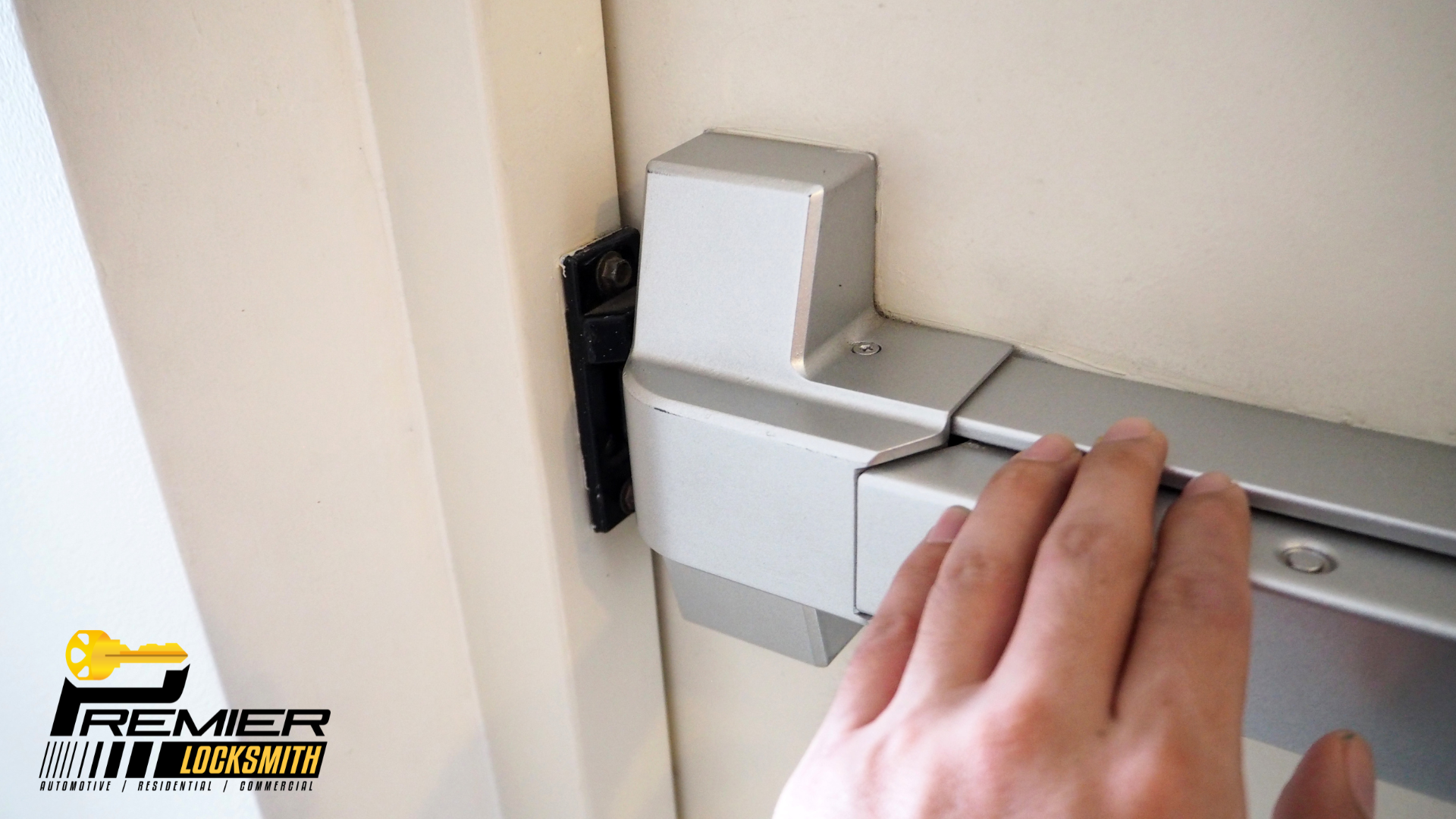Introduction
When you walk into a store, school, or hospital, you probably don’t think much about the door you came through—especially the one you’ll exit from. But in emergency situations, the door hardware can mean the difference between life and death.
Enter the push bar lock—also known as the panic bar, crash bar, or exit device.
Commonly found on commercial and public exit doors, push bar locks have a long and important history rooted in safety, fire codes, and mass evacuation scenarios. This article explores the origins, evolution, and importance of push bar locks in modern buildings, as well as how locksmiths like Premier Locksmith in Texas install, repair, and maintain them.
What Is a Push Bar Lock?
A push bar lock is a type of door locking mechanism commonly used in commercial and institutional settings. It consists of a horizontal bar placed across the interior side of an exit door. When the bar is pressed, the door unlatches, allowing the occupant to exit quickly and easily.
Key Features:
- One-motion exit: You push the bar and the door opens.
- Failsafe design: Allows exit even if the power is out or other systems fail.
- Compliance: Required in many buildings by international and national fire codes.
Common Names:
- Panic bar
- Crash bar
- Exit device
- Panic exit hardware
The Origins of the Push Bar Lock
The Catalyst: Victoria Hall Disaster (1883)
The invention of the push bar lock is tied to a tragic historical event: the Victoria Hall disaster in Sunderland, England, on June 16, 1883. During a performance for children, the building was overcrowded. At the end of the show, children rushed to the exits to receive prizes—but many of the exit doors were locked or opened inward, causing a deadly bottleneck.
Result:
- 183 children died from trampling and suffocation.
- The incident led to public outrage and demand for better building exit safety measures.
This tragedy highlighted the urgent need for doors that could be opened quickly and easily from the inside, even under pressure.
The Invention of the Panic Bar
In the early 20th century, inventors Robert Alexander Briggs and Carl Prinzler took this concept and developed the first panic bar (or “crash bar”). Their invention became known as the Von Duprin Panic Device, named after the company they co-founded: Von Duprin, Inc.
Timeline Highlights:
- 1908: Von Duprin introduces the first commercially available panic bar.
- 1920s–1950s: Widespread adoption in schools, theaters, and industrial buildings.
- 1960s–Present: Fire codes and building regulations mandate panic hardware for many public and commercial buildings.
How Push Bar Locks Work
Push bars are mounted on the interior side of outward-opening exit doors. When the bar is pushed, it retracts the latch mechanism, allowing the door to swing open.
Types of Push Bar Locks:
- Rim Panic Devices: Latch mounted on the surface of the door.
- Mortise Panic Devices: Latch concealed within the door itself.
- Vertical Rod Devices: Latches at the top and bottom of the door, used for double doors or high-security applications.
- Alarmed Exit Devices: Built-in alarms that trigger when the door is opened.
Where Push Bars Are Used Today
Push bar locks are required or recommended in buildings where:
- Occupancy is high (schools, theaters, arenas, restaurants).
- Quick egress is essential (hospitals, assisted living centers).
- Fire and safety codes apply (commercial and industrial buildings).
Common Locations:
- Schools and universities
- Hospitals and clinics
- Malls and retail stores
- Airports and transit hubs
- Warehouses and factories
- Churches and event centers
Why Push Bar Locks Are Required by Law
Various codes require panic hardware in specific situations:
1. International Building Code (IBC)
Requires panic hardware on exit doors in certain occupancy groups like:
- Assembly (group A)
- Education (group E)
- High hazard (group H)
2. National Fire Protection Association (NFPA)
- NFPA 101, Life Safety Code, also includes panic hardware mandates.
3. Americans with Disabilities Act (ADA)
Push bars must meet ADA standards for accessibility, meaning they must be easy to operate with minimal force and within specific height ranges.
Advantages of Push Bar Locks
- Speed and Ease of Use
Designed to allow fast exit in emergencies with minimal training. - Code Compliance
Helps businesses avoid fines and ensures legal compliance with safety codes. - Increased Safety During Emergencies
Avoids crowd congestion, bottlenecks, and panic during fires or active shooter scenarios. - Reduced Liability
Proper exit hardware minimizes the risk of injury lawsuits in emergencies.
Common Push Bar Issues and Maintenance
Despite their durability, push bar locks can experience wear and tear over time.
Common Problems:
- Loose or sticky bar mechanism
- Damaged latch bolts
- Misaligned doors preventing proper latch operation
- Alarm devices malfunctioning
- Corrosion from weather exposure (especially in coastal areas like Corpus Christi)
Maintenance Tips:
- Regular inspections (quarterly or biannually)
- Lubricate moving parts
- Ensure doors close and latch properly
- Test alarms and electronic components if applicable
The Role of Locksmiths in Push Bar Installation & Repair
1. Code-Compliant Installations
Licensed locksmiths ensure push bar systems are installed per local fire and building codes, including ADA standards.
2. Repairs and Replacements
If your push bar system fails or is outdated, professional locksmiths like Premier Locksmith can diagnose and fix issues quickly.
3. Retrofitting and Upgrading
Old buildings with outdated or non-compliant hardware can benefit from retrofitted panic devices.
4. Custom Configurations
Locksmiths can install:
- Electrified push bars for keyless entry/exit
- Alarmed bars for emergency exits only
- Weather-resistant hardware for exterior doors
Push Bar Locks in the Age of Smart Security
The future of push bars is now being integrated with smart technology:
- Electromagnetic Push Bars: Integrated with security systems, allowing remote monitoring and access control.
- AI Integration: Paired with occupancy sensors and surveillance to track traffic and detect threats.
- Mobile Access Controls: Users can unlock panic doors with mobile apps in controlled situations.
As buildings become smarter, push bar systems are being integrated into the overall access control ecosystem, creating a need for hybrid expertise from both locksmiths and tech professionals.
Why Choose Premier Locksmith for Push Bar Installation in Texas
At Premier Locksmith, we understand the critical importance of push bar locks in protecting lives, property, and businesses. Whether you’re managing a warehouse in Laredo, a retail store in Houston, or a school in Corpus Christi, we provide:
- 24/7 Emergency Service
- Commercial Code Compliance Installations
- Retrofitting and Alarm System Integration
- Fast Repairs and Routine Maintenance
Our mobile units are equipped to serve clients across Dallas, Houston, Laredo, Corpus Christi, and all of South Texas with licensed, insured, and experienced technicians.
Conclusion
Push bar locks may seem simple, but their history is rooted in tragedy, innovation, and life-saving engineering. From their beginnings after the Victoria Hall disaster to their modern AI-integrated versions, these devices are essential in commercial and public safety.
As regulations become stricter and buildings more complex, the demand for professional push bar lock installation and maintenance continues to grow. Whether you’re upgrading your building for compliance or need emergency repairs, Premier Locksmith is here to help.
Premier Locksmith – Your Trusted Partner for Push Bar Lock Solutions


